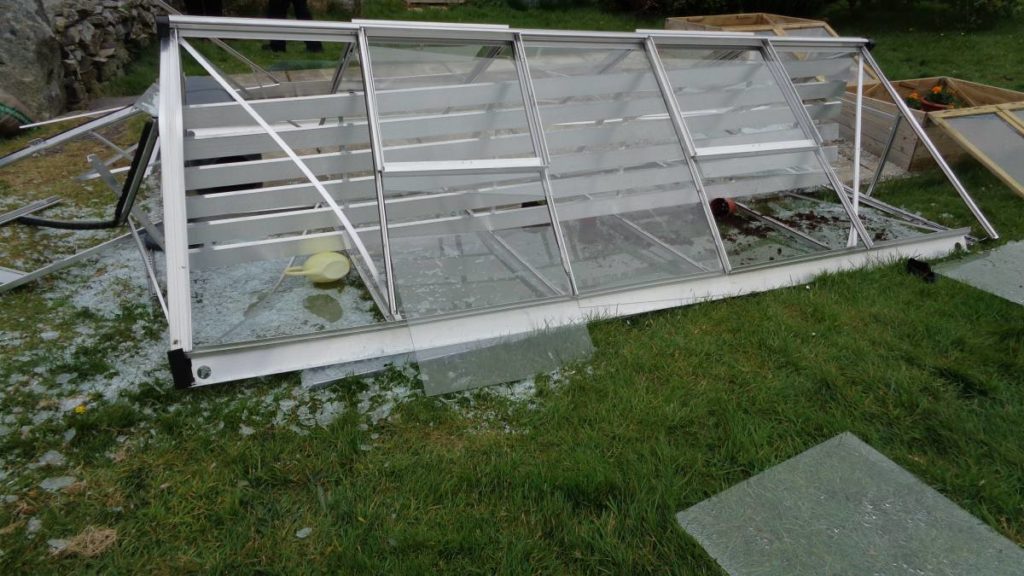Following Storm Hannah’s destruction of my new greenhouse, I’ve been thinking about what to do next.
I really don’t think there is any point in replacing it in the same position. It’s rare for the wind to gust from the direction it did directly towards the long face of the greenhouse. If it had been at an angle to the long face then it wouldn’t have exerted the same force.
The Force is Against Us
It’s interesting to look at the force wind can exert. The formula to calculate it is pretty straightforward. According to Mr Google..
Wind pressure is given by the equation P = 0.00256 x V2, where V is the speed of the wind in miles per hour (mph). The unit for wind pressure is pounds per square foot (psf).
A normal wind for here is 25 mph so the force of the wind would be 1.6 pounds per square foot. The flat area of the greenhouse is 50 sq ft so a total force of 80 pounds. Upping that windspeed to a storm speed of 40 mph increases the total force to 205 pounds. Just a 15 mph increase more than doubles the force.
The real problem is that the wind gusts. A 60 mph gust punches 460 pounds of force on the greenhouse and 80 mph increases that to 819! We have had gusts of 100 mph which would hit 1,280 pounds.
Putting a solid fence up would absorb that force but the wind going over the top will fill the void very quickly which is why trees are so effective as windbreaks. They don’t stop the wind, they slow it down and this reduces the eddying that the solid fence causes. A 30% reduction in wind velocity makes a big difference to the force of a gust. The force of that 80 mph gust would be more than halved to 401 pounds.
Since we moved here, it seems that severe storms have become more frequent so wind fencing is something to consider whatever we do. If the predictions of climate change are true, as I believe, things are only going to get worse for us all.
Polycrubs
One area that is no stranger to wind is the Shetland Islands. Hurricane winds in excess of 70 mph are not unusual and those, of course, gust higher. 101 mph has been recorded at ground level. Growing in their conditions is not easy.
The ideal is to grow tender crops under cover but even a good polytunnel is vulnerable in those conditions. So I was really interested to see this innovative solution to building robust growing shelters. See video at the end of this post.
Called a Polycrub it’s basically a super-tough, solid polytunnel utilising recycled salmon feed pipes from the salmon farming industry to form the structural support hoops. They’re not cheap but they’re permanent even in hurricanes.
According to their website, it’s called a Polycrub because:
Historically, Shetlanders needed sheltered space to grow-on young kale (cabbage) plants. Stone was their building material of choice and they built round, stone-walled shelters to nurture plants through the toughest conditions. Locally, this structure was known as a ‘planticrub’. Our building material of choice is polycarbonate, so we merged the name of our chosen 21st century material with a name from past growing history in Shetland. The ‘Polycrub’ was born.
Interestingly, in Lanzerote we noticed a similar walling system being used to shelter plants from the continually blowing trade winds. Very different in terms of temperature and rainfall but the same answer.
The winds aren’t as strong in Lanzerote but they are constant and dry out the plants. So sheltering from the wind also helps with the water supply – fresh water is a precious commodity on Lanzerote.






Yes you have got to get some kind of wind break, would be possible to turn your greenhouse 45 deg that may be a part solution
I’ve got an idea but need to think it through carefully – and pick a few other people’s brains.
John, I live in an exposed part of the Western Isles, where the winds are regularly 60mph+ and even potatoes are pulled up by the gusts! I got a polycrub last year and love it. They are increasingly popular in our wild and windy climate. Have a look at the polycrub page on FB, or talk to Maree in Shetland.
Good luck!
We have trouble from the North wind which blasted all the Bay trees (fortunately recovered over 2 years) So we planted a Winter garden consisting of willows and dogwoods (and other shrubs) and behind a fairly open fence with mixed hedging. After 3 years this has grown well and shields us from the worst of the blast from the North. We live in South Norfolk only 13 miles from Norwich and 40 mins from the North Sea.
I’ve planted quite a few trees (about 150) but the only one that’s fast growing is cypress leylandii. Slower but also less effect are goat willows.
If you ever visit Shetland you’ll notice that the slates on the gable ends of many houses are new as the force of the wind at times is enough to strip away slates.
Many polytunnels are constructed from very thick steel to withstand the winds.
Keder greenhouses are also worth looking at as they too are very strong.
I think you’re right in your previous comment in that with climate change we’re going to see more stormy conditions with strong winds
It’s simple really – as things heat up there’s more energy in the system. Compared to some countries like Mozambique we’ve got off very lightly so far.
I’d love to see the Shetlands but Val prefers warmer places for a holiday 🙂
Hi,
Had not heard of Polycrubs before… look interesting, although the sloping sides would restrict the height of the growing areas perhaps? We are in an exposed position in the Brecon Beacons and have a small storm-reinforced tunnel that we purchased, for a very reasonable price, as a kit from First Tunnels… and to date it has withstood all that the weather has thrown at it, whereas in the past 6 months we have had to repeatedly replace very many panes from the greenhouse! If a polytunnel is not for you, perhaps a Keder Greenhouse? Quite expensive but apparently extremely robust, withstanding the gales of the Falklands and the Shetlands! But, whatever you choose to do, I would definitely reeommend some for of windbreak… preferably trees.
It seems like you could have a bit of dilemma John what to do for the best not wanting this to happen again although that Polycrubs does look the business strong and robust but again cost does come into play. what tunnel life has the Polycrub have?
I must admit we wouldn’t have the winds here like your describing here when we had our first polytunnel we planted some conifers which did seem to protect the tunnel the poly cover lasted around 15 years that I thought was good. We built our first greenhouse next to the polytunnel and greenhouse also had protection from the conifers
Unfortunately the conifers got too tall and we had cut them down and they have been replaced by a new wall and wooden fence but its finding the best solution to your situation that’s not going to be easy.
Anyway I wish you luck in whatever you decide to buy I’m sure you will keep us updated what you intend to buy and replace.
I wasn’t actually thinking of a Polyscrub for me – it just seemed to be a great way of coping with somewhere even windier than here and using recycled materials.
I’ve a few ideas at the moment but, since it’s too late for this year, no great hurry to rush into a decision.
I fully understand and sympathise with your problems. One of the first projects done when we moved to mid west Ireland in 2009 was to have a Keder growhouse built. They have built a number of them in the Shetlands and Isle of Man, both of which are subject to strong winds. We also have a polytunnel which has had several repairs done due to Eleanor and Hector, it’s holding on but the Keder never moves. They may seem expensive in comparison but you know it’s still going to be standing next day. They also guarantee them ten years and they do a greenhouse version which you can build yourself and extend if necessary. So a serious answer to a serious problem.
We use angle aluminium as extra bracing with twin wall polycarbonate sheets replacing broken glazing. We are close to High Bradfield which gets gusts of 80+ regularly. So far our greenhouse has stood up to the storms. I will probably increase the internal bracing over summer to cope with the increased gust speeds we are getting.
It was second hand in 2003 and has moved homes a few times so we’ve had a good value from it.
My partner doesn’t rate the twin wall polycarbonate stating it doesn’t let enough light through. She’d go for thick glass with glazing strips to give a proper seal and additional internal bracing. In Orkney they put tensioned nets over greenhouses with guy ropes at the corners.
Not sure where your eqation’s factor comes from; presumably it takes account of shape of roof, height, age and roughness of glass. Pardon me I was into wind as an Engineer!
Our plot is atop a little valley. Twice a year and very predicably, we get a very strong swirling wind. Hard to stand up. First year on allotment we had two inherited g/h’s. One ended up three allotments away and one just collapsed like yours.
I aquired two new one -one free and one for £50. I built a concrete block base for each, thin edge up. One block underground and half of the second block above ground. This was reinforced with 1.5″ angle 2’6″ long, driven into the ground at the walls corners. A wooden 4″X4″ frame was anchor bolted on to blocks. The green house’s base frame was screwed to the wood with stainless screws & big washers. Just make sure it is all level and it is not on a track for Sherman tanks and you will be OK.
WInd force was an estimate based on the size of greenhouse, wind speed estimate and using the formula from https://www.wikihow.com/Calculate-Wind-Load
Part of our problem here is that we’re high up (600 feet) and open – it’s a clear run from Ireland to us. 🙁
the Haygrove polytunnel is exported to the Falklands and stands up to the winds there